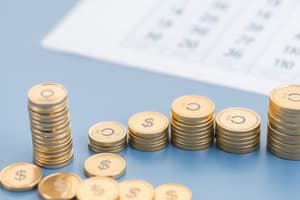Podcast
Questions and Answers
What is the primary reason for depreciating an asset?
What is the primary reason for depreciating an asset?
- To accurately reflect the asset's fair market value over time.
- To reduce the asset's value to zero by the end of its useful life.
- To accumulate cash for replacement of the asset.
- To allocate the cost of the asset over its useful life. (correct)
What are the three main factors considered when calculating depreciation?
What are the three main factors considered when calculating depreciation?
- Cost, salvage value, and depreciation rate.
- Market value, salvage value, and depreciation rate.
- Cost, salvage value, and estimated useful life. (correct)
- Cost, market value, and estimated useful life.
Which depreciation method allocates a constant amount of depreciation expense each year?
Which depreciation method allocates a constant amount of depreciation expense each year?
- Diminishing-balance method.
- Straight-line method. (correct)
- Units-of-production method.
- Accelerated depreciation method.
Which depreciation method bases the depreciation expense on the asset's carrying amount?
Which depreciation method bases the depreciation expense on the asset's carrying amount?
What is the estimated value of an asset at the end of its useful life called?
What is the estimated value of an asset at the end of its useful life called?
What is the carrying amount of an asset?
What is the carrying amount of an asset?
How often should the depreciation method, estimated useful life, and residual value of an asset be reviewed?
How often should the depreciation method, estimated useful life, and residual value of an asset be reviewed?
Which depreciation method is often used for assets that have a high rate of use in the early years of their life?
Which depreciation method is often used for assets that have a high rate of use in the early years of their life?
What is the first step in recording a disposal of property, plant, and equipment?
What is the first step in recording a disposal of property, plant, and equipment?
How is the carrying amount of an asset calculated?
How is the carrying amount of an asset calculated?
If the proceeds from a disposal are greater than the carrying amount, what is the result?
If the proceeds from a disposal are greater than the carrying amount, what is the result?
When exchanging an old asset for a new one, what is the trade-in allowance used for?
When exchanging an old asset for a new one, what is the trade-in allowance used for?
What is the relevant value used when recording a new asset acquired through an exchange, in relation to the old asset given up?
What is the relevant value used when recording a new asset acquired through an exchange, in relation to the old asset given up?
What is the final step in recording an exchange of property, plant, and equipment?
What is the final step in recording an exchange of property, plant, and equipment?
In a retirement of property, plant, and equipment where no proceeds are received, what is the journal entry to record the retirement?
In a retirement of property, plant, and equipment where no proceeds are received, what is the journal entry to record the retirement?
When an asset is retired and it is not fully depreciated, what is the loss on retirement equal to?
When an asset is retired and it is not fully depreciated, what is the loss on retirement equal to?
What are the two key characteristics that distinguish natural resources from other long-lived assets?
What are the two key characteristics that distinguish natural resources from other long-lived assets?
How is the cost of natural resources determined?
How is the cost of natural resources determined?
Which depreciation method is typically used to calculate the depletion of natural resources?
Which depreciation method is typically used to calculate the depletion of natural resources?
How is the depletion expense of natural resources recorded in the accounting system?
How is the depletion expense of natural resources recorded in the accounting system?
When a company sells a product extracted from a natural resource, what is the accounting treatment for the depletion expense?
When a company sells a product extracted from a natural resource, what is the accounting treatment for the depletion expense?
What is the primary difference between depreciation of plant assets and depletion of natural resources?
What is the primary difference between depreciation of plant assets and depletion of natural resources?
What are the future restoration and clean-up costs associated with a natural resource called?
What are the future restoration and clean-up costs associated with a natural resource called?
What is the accounting implication of the depletion expense for a company's financial statements?
What is the accounting implication of the depletion expense for a company's financial statements?
Which of the following costs would be included in the cost of land?
Which of the following costs would be included in the cost of land?
Which of the following is NOT a characteristic of property, plant, and equipment (PP&E)?
Which of the following is NOT a characteristic of property, plant, and equipment (PP&E)?
What is the difference between capital expenditures and operating expenditures?
What is the difference between capital expenditures and operating expenditures?
What costs would be included in the cost of a building if it is constructed?
What costs would be included in the cost of a building if it is constructed?
Which of the following is NOT a class of property, plant, and equipment?
Which of the following is NOT a class of property, plant, and equipment?
Which of the following costs would be included in the cost of equipment?
Which of the following costs would be included in the cost of equipment?
What is the primary reason for distinguishing between capital expenditures and revenue expenditures?
What is the primary reason for distinguishing between capital expenditures and revenue expenditures?
What is the term used to describe the process of allocating the cost of a long-lived asset over its useful life?
What is the term used to describe the process of allocating the cost of a long-lived asset over its useful life?
When a company purchases multiple assets for a single price, what is the process called?
When a company purchases multiple assets for a single price, what is the process called?
What is the primary accounting principle that guides the allocation of costs to multiple assets purchased together?
What is the primary accounting principle that guides the allocation of costs to multiple assets purchased together?
Which of the following is NOT a factor considered when determining the cost of a long-lived asset?
Which of the following is NOT a factor considered when determining the cost of a long-lived asset?
What is the accounting treatment for the disposal of a long-lived asset?
What is the accounting treatment for the disposal of a long-lived asset?
What type of expenditure is the cost of repairing a building?
What type of expenditure is the cost of repairing a building?
Which of the following is NOT a characteristic of intangible assets?
Which of the following is NOT a characteristic of intangible assets?
What is the difference between land and land improvements?
What is the difference between land and land improvements?
Which of the following is an example of an intangible asset with an indefinite life?
Which of the following is an example of an intangible asset with an indefinite life?
What is the main purpose of using the units-of-production method to calculate depreciation?
What is the main purpose of using the units-of-production method to calculate depreciation?
When using the units-of-production method, what factor needs to be estimated in advance?
When using the units-of-production method, what factor needs to be estimated in advance?
When a fully depreciated asset is still being used, how should it be accounted for on the balance sheet?
When a fully depreciated asset is still being used, how should it be accounted for on the balance sheet?
Why does depreciation expense have to be recorded for a partial period when equipment is sold in the middle of a fiscal year?
Why does depreciation expense have to be recorded for a partial period when equipment is sold in the middle of a fiscal year?
How is the gain or loss on the exchange of property, plant, or equipment calculated?
How is the gain or loss on the exchange of property, plant, or equipment calculated?
Which of the following is an example of a property, plant, and equipment asset?
Which of the following is an example of a property, plant, and equipment asset?
How is the cost of a newly acquired piece of equipment typically determined?
How is the cost of a newly acquired piece of equipment typically determined?
What is the primary goal of depreciation accounting?
What is the primary goal of depreciation accounting?
Flashcards
Capital Expenditures
Capital Expenditures
Expenses that improve or extend the life of an asset.
Revenue Expenditures
Revenue Expenditures
Costs that maintain an asset but do not improve it.
Amortization
Amortization
The process of expensing the cost of intangible assets over time.
Depreciation
Depreciation
Signup and view all the flashcards
Disposal of Assets
Disposal of Assets
Signup and view all the flashcards
Tangible Assets
Tangible Assets
Signup and view all the flashcards
Intangible Assets
Intangible Assets
Signup and view all the flashcards
Goodwill
Goodwill
Signup and view all the flashcards
Cost Determination
Cost Determination
Signup and view all the flashcards
Operating Expenditures
Operating Expenditures
Signup and view all the flashcards
Cost of Land
Cost of Land
Signup and view all the flashcards
Land Improvements
Land Improvements
Signup and view all the flashcards
Building Costs
Building Costs
Signup and view all the flashcards
Equipment Costs
Equipment Costs
Signup and view all the flashcards
Multiple Assets Purchase
Multiple Assets Purchase
Signup and view all the flashcards
Cost of Property, Plant, and Equipment
Cost of Property, Plant, and Equipment
Signup and view all the flashcards
Depreciation Calculation
Depreciation Calculation
Signup and view all the flashcards
Useful Life
Useful Life
Signup and view all the flashcards
Residual Value
Residual Value
Signup and view all the flashcards
Units-of-Production Method
Units-of-Production Method
Signup and view all the flashcards
Depreciation Methods
Depreciation Methods
Signup and view all the flashcards
Straight-Line Method
Straight-Line Method
Signup and view all the flashcards
Depreciable Cost
Depreciable Cost
Signup and view all the flashcards
Total Units of Production
Total Units of Production
Signup and view all the flashcards
Diminishing-Balance Method
Diminishing-Balance Method
Signup and view all the flashcards
Depreciation Expense
Depreciation Expense
Signup and view all the flashcards
Units-of-Production Method
Units-of-Production Method
Signup and view all the flashcards
Balance Sheet Accounting
Balance Sheet Accounting
Signup and view all the flashcards
Partial Period Depreciation
Partial Period Depreciation
Signup and view all the flashcards
Gain or Loss on Exchange
Gain or Loss on Exchange
Signup and view all the flashcards
Retirement of Property, Plant, and Equipment
Retirement of Property, Plant, and Equipment
Signup and view all the flashcards
Disposal Process Steps
Disposal Process Steps
Signup and view all the flashcards
Carrying Amount
Carrying Amount
Signup and view all the flashcards
Gain or Loss Calculation
Gain or Loss Calculation
Signup and view all the flashcards
Retirement of Asset
Retirement of Asset
Signup and view all the flashcards
Trade-in Allowance
Trade-in Allowance
Signup and view all the flashcards
Fair Value in Exchanges
Fair Value in Exchanges
Signup and view all the flashcards
Updating Depreciation
Updating Depreciation
Signup and view all the flashcards
Cash Paid Calculation
Cash Paid Calculation
Signup and view all the flashcards
Natural Resources
Natural Resources
Signup and view all the flashcards
Wasting Assets
Wasting Assets
Signup and view all the flashcards
Cost of Extracting
Cost of Extracting
Signup and view all the flashcards
Asset Retirement Costs
Asset Retirement Costs
Signup and view all the flashcards
Cost of Goods Sold
Cost of Goods Sold
Signup and view all the flashcards
Study Notes
Chapter 9: Long-Lived Assets
- This chapter covers long-lived assets, including property, plant, equipment, natural resources, and intangible assets.
- Learning goals include distinguishing capital from revenue expenditures, recording transactions related to amortization, disposal, and depletion of tangible assets, identifying elements for determining plant and equipment costs, natural resources and intangibles, and recording transactions for intangible assets.
- Success criteria include determining costs of property, plant & equipment, explaining & calculating depreciation, accounting for disposal of property, plant & equipment, calculating & recording depreciation of natural resources and identifying intangible asset & goodwill accounting issues.
Property, Plant, and Equipment
- Long-lived assets owned by a company; used in production and sale of goods and services.
- Characteristics:
- Have physical substance (size and shape)
- Used in business operations.
- Not intended for sale to customers.
- Expected to provide services for several years.
- Divided into four classes: land, land improvements, buildings, and equipment.
Determining Cost
- Cost includes purchase price, non-recoverable taxes, less discounts, and rebates.
- Includes all costs necessary to bring the asset to its location and ready-for-use condition, including obligations to remove or restore the asset upon retirement.
- Capital expenditures benefit future periods; operating expenditures benefit only the current period.
Land and Improvements
- Land cost includes the purchase price, closing costs (e.g., legal fees, surveys), and costs to prepare the land for intended use.
- Land improvements are additions to land (e.g., fences, parking lots, landscaping); they have limited useful lives and are separately recorded and depreciated.
Buildings
- Building costs include purchase price, closing costs, and costs to get the building ready for its intended use (e.g., renovations, repairs).
- Construction costs include contract price, architects' fees, building permits, construction interest, and excavation costs.
Equipment
- Equipment includes delivery equipment, office equipment, computers, machinery, vehicles, furniture, fixtures, and other similar assets.
- The cost includes the purchase price, freight, insurance during transit, and assembly, installation, and testing costs.
Multiple Assets
- If multiple assets are purchased together for a single price, the total cost is allocated to each asset in proportion to its relative fair value. This method is called a basket purchase.
Depreciation
- Systematic allocation of the cost of a long-lived asset over its useful life.
- It's a process of cost allocation (not determining fair value).
- It does not accumulate cash for replacement.
Calculating Depreciation
- To calculate depreciation, determine:
- The cost to acquire the asset and prepare it for use.
- The estimated useful (productive) life of the asset (expressed as time, units of activity, or units of output).
- The estimated residual value (value at the end of its useful life).
Depreciation Methods
- Three depreciation methods to choose from:
- Straight-line
- Diminishing-balance
- Units-of-production
Straight-Line Method
- Depreciation expense is constant each year of the asset's useful life.
- Depreciable amount is calculated by subtracting the residual value from the cost.
- Annual depreciation expense is calculated by dividing the depreciable amount by the estimated useful life.
Diminishing-Balance Method
- Depreciation expense is based on the asset's diminishing carrying amount (cost less accumulated depreciation).
- The depreciation rate remains constant, but depreciation expense declines each year.
Units-of-Production Method
- Useful life is expressed as total units of production or activity.
- The total estimated units of production are used to determine the depreciation cost per unit.
- Annual depreciation expense is calculated by multiplying the depreciable amount per unit by the units of production during the year.
Natural Resources
- Natural resources (wasting assets) include standing timber, oil, gas, and minerals.
- They differ from other long-lived assets because they are physically extracted, depleted, and replaced only by nature.
- The cost of natural resources includes costs to acquire, prepare, and use them while future restoration/clean-up costs are added.
- Depreciation is calculated using the units-of-production method and debited to inventory.
- The cost is expensed when the product is sold.
Intangible Assets
- Intangible assets represent rights, privileges, and competitive advantages without physical substance, like patents, copyrights, trademarks, franchises, and licenses.
- Recorded at cost (including costs to prepare an asset for use).
- Amortized (depreciated) over their finite useful or legal life, whichever is shorter, and this often uses the straight-line method.
- Assets with indefinite lives are not amortized.
Goodwill
- Goodwill represents the value of favorable attributes of a company acquired in a business purchase; it's recorded when a business is acquired.
Studying That Suits You
Use AI to generate personalized quizzes and flashcards to suit your learning preferences.




